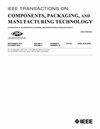Robustness of Large-Size Vacuum Sealed Packages for Microbolometer Array
IF 2.3
3区 工程技术
Q2 ENGINEERING, ELECTRICAL & ELECTRONIC
IEEE Transactions on Components, Packaging and Manufacturing Technology
Pub Date : 2024-09-17
DOI:10.1109/TCPMT.2024.3462818
引用次数: 0
Abstract
Microbolometers are the core detectors of uncooled thermal sensors. These detectors require a high vacuum environment (<1>用于微测辐射热计阵列的大型真空密封封装的稳健性
微测辐射热计是非制冷热传感器的核心探测器。这些探测器需要在高真空环境(12 毫米)下使用晶圆级铜-锰 SLID 封装,使用随时间变化的电容偏转研究,并将其暴露在湿度和热冲击测试环境中。晶圆级瓶盖挠度测量结果表明,芯片在接合后保持稳定真空状态的时间超过 13 个月,然后才暴露在恶劣的环境中。铜-锰 SLID 封装显示出对腐蚀影响的适应能力,93% 的芯片通过了湿度测试。相反,由于 Cu/Cu3Sn/Cu 键合线出现垂直裂纹,所有模具都未能通过热冲击测试。这些垂直裂纹主要是通过 Cu3Sn 的空隙传播的,而此处的应力被认为是最大的。为了减少垂直裂纹的形成并提高密封框架的长期完整性,必须尽量减少空隙的形成。因此,对电镀工艺提出了严格的要求,以避免污染,这就要求对电镀槽条件进行仔细监控,并优化电镀参数。
本文章由计算机程序翻译,如有差异,请以英文原文为准。
求助全文
约1分钟内获得全文
求助全文
来源期刊

IEEE Transactions on Components, Packaging and Manufacturing Technology
ENGINEERING, MANUFACTURING-ENGINEERING, ELECTRICAL & ELECTRONIC
CiteScore
4.70
自引率
13.60%
发文量
203
审稿时长
3 months
期刊介绍:
IEEE Transactions on Components, Packaging, and Manufacturing Technology publishes research and application articles on modeling, design, building blocks, technical infrastructure, and analysis underpinning electronic, photonic and MEMS packaging, in addition to new developments in passive components, electrical contacts and connectors, thermal management, and device reliability; as well as the manufacture of electronics parts and assemblies, with broad coverage of design, factory modeling, assembly methods, quality, product robustness, and design-for-environment.
 求助内容:
求助内容: 应助结果提醒方式:
应助结果提醒方式:


